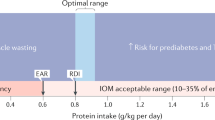Abstract
Efforts to combat nutrient deficiencies have centered on supplemental nutrient administration and addition of selected nutrients to the food chain in the form of food fortification. Over the past several decades, and as the association between diet and chronic diseases became apparent, supplementation and fortification were also targeted at healthy individuals, with the aim of reducing their risk of future diseases such as cardiovascular diseases, diabetes, and cancer. While supplementation strategies are playing a major role in reducing micronutrient deficiencies around the world, there is less compelling evidence for their role in reducing risk of chronic diseases in healthy individuals, perhaps with the exception of folic acid and reduction of neural tube defects. Nevertheless, with our increasing understanding of the genetic heterogeneity of human nutrient requirements, it is likely that certain groups or populations may clearly benefit from higher intakes of certain nutrients. In addition to supplementation or fortification with specific nutrients, the consumption of certain dietary patterns (such as the Mediterranean diet) is associated with a reduced risk of chronic diseases, particularly cardiovascular diseases.
This is a preview of subscription content, access via your institution
Access options
Subscribe to this journal
Receive 12 print issues and online access
$259.00 per year
only $21.58 per issue
Buy this article
- Purchase on Springer Link
- Instant access to full article PDF
Prices may be subject to local taxes which are calculated during checkout


Similar content being viewed by others
References
Appel LJ, Moore TJ, Obarzanek E, Vollmer WM, Svetkey LP, Sacks FM, Bray GA, Vogt TM, Cutler JA, Windhauser MM, Lin PH & Karanja N (1997): A clinical trial of the effects of dietary patterns on blood pressure. DASH Collaborative Research Group. New Engl. J. Med. 336, 1117–1124.
Bhutta ZA, Black RE, Brown KH, Gardner JM, Gore S, Hidayat A, Khatun F, Martorell R, Ninh NX, Penny ME, Rosado JL, Roy SK, Ruel M, Sazawal S & Shankar A (1999): Prevention of diarrhea and pneumonia by zinc supplementation in children in developing countries: pooled analysis of randomized controlled trials. Zinc Investigators' Collaborative Group. J. Pediatr. 135, 689–697.
Bron D & Asmis R (2001): Vitamin E and the prevention of atherosclerosis. Int. J. Vitam. Nutr. Res. 71, 18–24.
Eichholzer M, Luthy J, Gutzwiller F & Stahelin HB (2001): The role of folate, antioxidant vitamins and other constituents in fruit and vegetables in the prevention of cardiovascular disease: the epidemiological evidence. Int. J. Vitam. Nutr. Res. 71, 5–17.
Feinleib M, Beresford SA, Bowman BA, Mills JL, Rader JI, Selhub J & Yetley EA (2001): Folate fortification for the prevention of birth defects: case study. Am. J. Epidemiol. 154(Suppl), S60–S69.
Harsha DW, Lin PH, Obarzanek E, Karanja N, Moore TJ & Caballero B (1999): Dietary approaches to stop hypertension: a summary of study results. J. Am. Diet. Assoc. 99, 35–39.
Institute of Medicine (1998): Standing Committee on the Scientific Evaluation of Dietary Reference Intakes: Proposed Definition and Plan for Review of Dietary Antioxidants and Related Compounds. Washington, DC: National Academy Press.
McGee DL, Reed DM, Yano K, Kagan A & Tillotson J (1984): Ten-year incidence of coronary heart disease in the Honolulu heart program: relationship to nutrient intake. Am. J. Epidemiol. 119, 667–676.
MRFIT Research Group (1982): Multiple risk factor intervention trial: risk factor changes and mortality results. JAMA 248, 1465–1477.
Shekelle RB, Shryock AM, Paul O, Lepper M, Stamler J, Liu S & Raynor Jr WJ (1981): Diet, serum cholesterol, and death from coronary heart disease: the Western Electric Study. New Engl. J. Med. 304, 65–70.
Sommer A, Tarwotjo I, Djunaedi E, West KP, Loeden AA & Tilden R (1986): Impact of vitamin A supplementation on childhood mortality. Lancet 1, 1169–1173.
Watkins ML, Erickson JD, Thun JD, Mulinare J & Heath Jr CW (2000): Multivitamin use and mortality in a large prospective study. Am. J. Epidemiol. 152, 149–162.
Author information
Authors and Affiliations
Contributions
Guarantor: B Caballero.
Corresponding author
Rights and permissions
About this article
Cite this article
Caballero, B. Fortification, supplementation, and nutrient balance. Eur J Clin Nutr 57 (Suppl 1), S76–S78 (2003). https://doi.org/10.1038/sj.ejcn.1601803
Published:
Issue Date:
DOI: https://doi.org/10.1038/sj.ejcn.1601803
Keywords
This article is cited by
-
Effects of Curculigo pilosa supplementation on antioxidant and antidiabetic activities of yam flour
Journal of Food Science and Technology (2021)
-
Single-nucleotide polymorphisms in one-carbon metabolism genes, Mediterranean diet and breast cancer risk: a case–control study in the Greek-Cypriot female population
Genes & Nutrition (2015)



